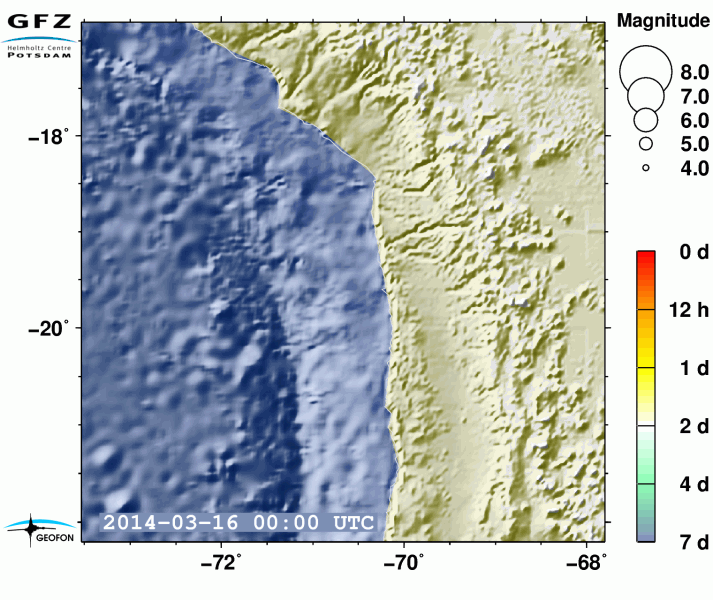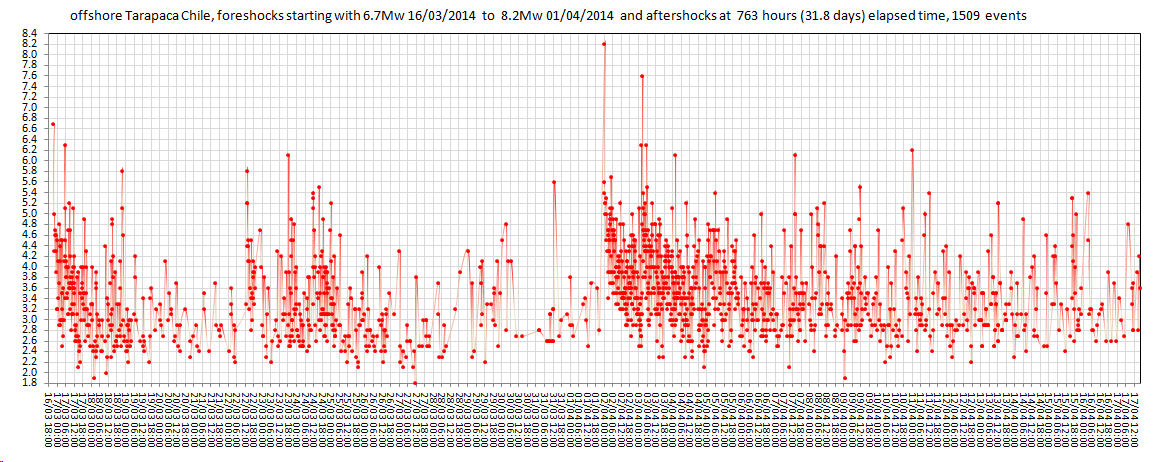It looks like you're using an Ad Blocker.
Please white-list or disable AboveTopSecret.com in your ad-blocking tool.
Thank you.
Some features of ATS will be disabled while you continue to use an ad-blocker.
share:
Another aftershock just hit, waiting on mag.
Estimate 5.8 to 6.2
That's still showing some energy left in the fault, when it had finally appeared to be dying down. *sigh*
EMSC: 5.8
USGS: still waiting... probably a 6 from them.
USGS: 5.8
But there was also two other quakes after that, a 5.0 and another still waiting on.....Hmm. Be safe down there peoples...
EMSC: 5.8, 5.3, 5.0
USGS: 5.8, 5.3, 5.1
Estimate 5.8 to 6.2
That's still showing some energy left in the fault, when it had finally appeared to be dying down. *sigh*
edit on Mon Apr 7th 2014 by
TrueAmerican because: (no reason given)
EMSC: 5.8
USGS: still waiting... probably a 6 from them.
edit on Mon Apr 7th 2014 by TrueAmerican because: (no reason given)
USGS: 5.8
But there was also two other quakes after that, a 5.0 and another still waiting on.....Hmm. Be safe down there peoples...
edit on Mon Apr 7th
2014 by TrueAmerican because: (no reason given)
edit on Mon Apr 7th 2014 by TrueAmerican because: (no reason given)
EMSC: 5.8, 5.3, 5.0
edit on Mon Apr 7th 2014 by TrueAmerican because: (no reason given)
USGS: 5.8, 5.3, 5.1
edit on Mon Apr 7th 2014 by TrueAmerican because: (no reason given)
reply to post by TrueAmerican
I think EMSC is low, compared to notes I scratched down last week--to compare amplitudes in GEE. My guess is closer to mag 6.1 to 6.2.
ETA: Good morning.
2nd edit:
USGS also have it as Mag 5.8. If that is their finally answer, then they have some adjusting to do on a couple of Mag 6.2's from April 1st & 3rd.
I think EMSC is low, compared to notes I scratched down last week--to compare amplitudes in GEE. My guess is closer to mag 6.1 to 6.2.
ETA: Good morning.
edit on 4/7/2014 by Olivine because: (no reason given)
2nd edit:
USGS also have it as Mag 5.8. If that is their finally answer, then they have some adjusting to do on a couple of Mag 6.2's from April 1st & 3rd.
edit on 4/7/2014 by Olivine because: (no reason given)
reply to post by Olivine
Looks a bit low to me too, but don't forget exact distance to station. Even 10 kilometers difference that attenuate those waves will drop that magnitude down from a previous one closer.
Then again, you could always ask our newfound seismologist/geologist expert. *chuckle*
lol, EMSC just revised that 5.8 down to a 5.7. You get the feeling they don't like us very much? I do.
Looks a bit low to me too, but don't forget exact distance to station. Even 10 kilometers difference that attenuate those waves will drop that magnitude down from a previous one closer.
Then again, you could always ask our newfound seismologist/geologist expert. *chuckle*
edit on Mon Apr 7th 2014 by TrueAmerican
because: (no reason given)
lol, EMSC just revised that 5.8 down to a 5.7. You get the feeling they don't like us very much? I do.
edit on Mon Apr 7th 2014 by
TrueAmerican because: (no reason given)
I saw this neat animation of the earthquake series offshore Iquique, on the Pacific NW Seismic Network FB page.
It begins on 16 March 2014, the same day as this thread.
From GFZ Potsdam

It begins on 16 March 2014, the same day as this thread.
From GFZ Potsdam

edit on 4/8/2014 by Olivine because: fix link
reply to post by Olivine

look up Newton His Life and times,,its hard too find.


look up Newton His Life and times,,its hard too find.

edit on 4/8/2014 by BobAthome because: (no reason given)
reply to post by JustMike
I have deleted that M9.7 error that was in Ecuador 1827/11/16, thanks for pointing that out Mike.
and added this 8.2 to the M8+ map (1700 years of data)
I have deleted that M9.7 error that was in Ecuador 1827/11/16, thanks for pointing that out Mike.
and added this 8.2 to the M8+ map (1700 years of data)
edit on 04u999914 by muzzy because: (no reason given)
TA I want to say one thing. You are AMAZING, not taking anything away from puterman and muzzy, but the amount of time and effort you put into what you
do is inspiring.
Regardless of what any haters or non believers say. I have never seen anyone make accurate predictions of location and magnitudemagnitude like you have.
Keep on keeping on brother, you are an amazing part of this community and a huge part of what makes it great.
Regardless of what any haters or non believers say. I have never seen anyone make accurate predictions of location and magnitudemagnitude like you have.
Keep on keeping on brother, you are an amazing part of this community and a huge part of what makes it great.
edit on 04pm84000000041188 by
magnum1188 because: spelling
Thanks to rickymouse for pointing out this article in my other thread on Solomon Islands. But really it should be here:
www.sciencedaily.com...
More at article.
This provides some more "official" concern over the Chile situation- that it still may not be done. Too bad officials won't take any chances and warn the public with a specific seismic hazard warning. I did. And would have been glad to be wrong. They're warning now though, huh. And a warning doesn't consist of some buried concern in a behind-a-pay-wall scientific document. What I want is for them to call up the emergency management services and say "Look, we have some strong seismicity occurring here, and it's possible they could be foreshocks. Could you please broadcast a warning of some kind to the public via media. Hopefully we are wrong."
HA. No chance in hell of that. Scientists HATE to be wrong.
No All-Clear
Initial analyses conducted by GFZ seismologists have shown that there is no sign that tension in the earth' crust has significantly decreased: "So far tension has been released only in the central section of this vulnerable zone," Oncken further explains. The series of earthquakes began on March 16 with a 6.7-magnitude earthquake. Although the main earthquake with a magnitude of 8.1 broke the central section of the seismic gap of a length of some 100 kilometres, two large segments further north and south remain intact, and these segments are able to cause strong earthquakes with a high risk of ground shaking and tsunamis.Oncken: "This means that the risk of one or even several earthquakes with a magnitude clearly above 8 still exists." Furthermore, the location and magnitude of the aftershocks suggest such a scenario.
Since the main quake struck, hundreds of aftershocks have been registered, the strongest that of April 2 (CEST) of a magnitude of 7.6. This earthquake struck about 100 kilometres south of the main earthquake's epicentre. Together with the its associated aftershocks, it forms a second rupture zone.
www.sciencedaily.com...
More at article.
This provides some more "official" concern over the Chile situation- that it still may not be done. Too bad officials won't take any chances and warn the public with a specific seismic hazard warning. I did. And would have been glad to be wrong. They're warning now though, huh. And a warning doesn't consist of some buried concern in a behind-a-pay-wall scientific document. What I want is for them to call up the emergency management services and say "Look, we have some strong seismicity occurring here, and it's possible they could be foreshocks. Could you please broadcast a warning of some kind to the public via media. Hopefully we are wrong."
HA. No chance in hell of that. Scientists HATE to be wrong.
new topics
-
Meta Llama local AI system is scary good
Science & Technology: 27 minutes ago -
This is why ALL illegals who live in the US must go
US Political Madness: 2 hours ago -
UK Borders are NOT Secure!
Social Issues and Civil Unrest: 3 hours ago -
Former ‘GMA Producer’ Sues NPR-Legacy Media Exposed
Propaganda Mill: 5 hours ago -
New Footage - Randy Rhoads 1979 LIVE Guitar Solo Footage at the Whisky - Pro Shot
Music: 6 hours ago -
Happy Hanukkah…
General Chit Chat: 6 hours ago
top topics
-
Former ‘GMA Producer’ Sues NPR-Legacy Media Exposed
Propaganda Mill: 5 hours ago, 8 flags -
A Merry Christmas.
General Chit Chat: 13 hours ago, 7 flags -
This is why ALL illegals who live in the US must go
US Political Madness: 2 hours ago, 7 flags -
Happy Hanukkah…
General Chit Chat: 6 hours ago, 6 flags -
New Footage - Randy Rhoads 1979 LIVE Guitar Solo Footage at the Whisky - Pro Shot
Music: 6 hours ago, 5 flags -
UK Borders are NOT Secure!
Social Issues and Civil Unrest: 3 hours ago, 5 flags -
Meta Llama local AI system is scary good
Science & Technology: 27 minutes ago, 2 flags
active topics
-
Happy Hanukkah…
General Chit Chat • 18 • : Cloudbuster1 -
Meta Llama local AI system is scary good
Science & Technology • 3 • : glend -
This is why ALL illegals who live in the US must go
US Political Madness • 7 • : hangedman13 -
Plane Crash Today --Azerbaijanian E190 passenger jet
Mainstream News • 36 • : Oldcarpy2 -
FAA Investigates Christmas Drone Show Gone Wrong in Orlando, FL 12/2024
Other Current Events • 11 • : ScottKirkland -
It's Offical Now
US Political Madness • 26 • : Oldcarpy2 -
This is an interesting picture. Do we actually pick our leaders?
Politicians & People • 13 • : GENERAL EYES -
Panamanian President-“every square meter” of the Panama Canal belongs to Panama.
New World Order • 45 • : SCUBAPAUL -
-@TH3WH17ERABB17- -Q- ---TIME TO SHOW THE WORLD--- -Part- --44--
Dissecting Disinformation • 3820 • : Thoughtful3 -
Cold Blooded Killers on Christmas!! GRRRRrrr!!
Pets • 13 • : SCUBAPAUL

